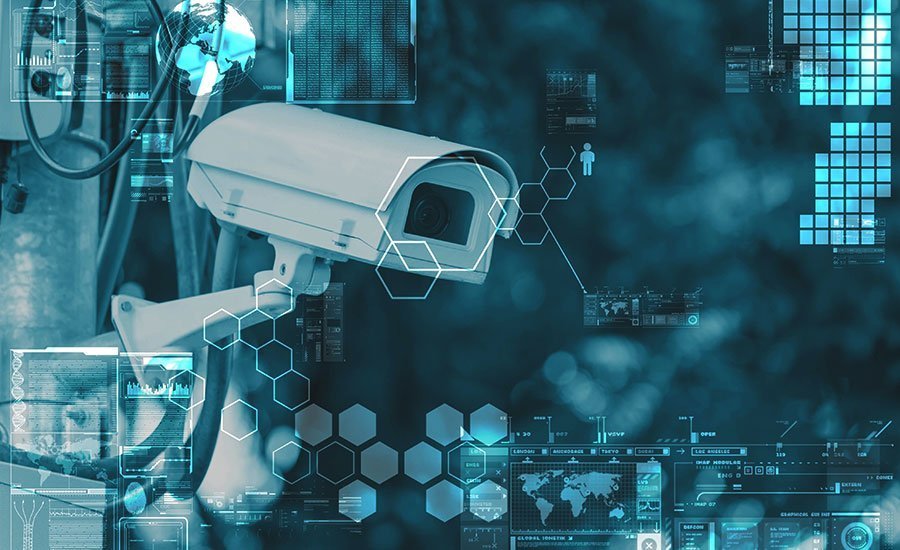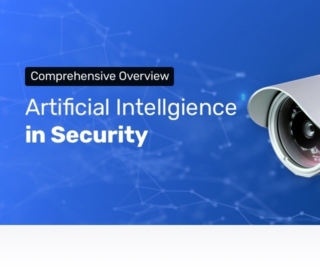
As of now, numerous companies claim to assist security firms, the military, and consumers prevent crime and defend their buildings, homes, and personal belongings.
We researched the space to better understand where AI comes into play in the physical security industry and to answer the following questions:
- What types of AI applications are currently in use in physical security?
- What tangible results has AI driven in physical security?
- Are there any common trends among these innovation efforts? How could these trends affect the future of physical security?
This report covers vendors offering software with 4 applications:
- Access control for Large Events and Crowds
- Military defense
- Home surveillance
- Surveillance of wide-area facilities
This article intends to provide business leaders in the security space with an idea of what they can currently expect from Ai in their industry. We hope that this article allows business leaders in security to garner insights they can confidently relay to their executive teams so they can make informed decisions when thinking about AI adoption. At the very least, this article intends to act as a method of reducing the time business leaders in physical security spend researching AI companies with whom they may (or may not) be interested in working.
Access Control for Large Events and Crowds
Evolv Technology
Evolv Technology claims to offer a physical security system that consists of the Evolve Edge personnel threat screening machine that works with the Evolv Pinpoint automated facial recognition application.
The company says its screening machine’s physical design allows 600 to 900 people to walk through per hour, or at least one person per second. The company claims to eliminate bottlenecks and long lines without the need for customers to stop and pose or empty pockets.
The company explains that the database can contain approved profiles of persons such as VIPs, regular company employees, season ticket holders for events, repeat patrons, and other persons who should be allowed entry to a venue.
Evolv Technology claims their machines could be used at airports, major events, schools, commercial and business buildings, government offices, and other public places. The wheels at the bottom of the machine allow security users to easily move it in order to create checkpoints.
To use the machine, users set it up at the entrance of a venue and allow visitors to walk through it normally.
The built-in facial recognition camera captures video footage as the visitors approach, while Evolv Pinpoint’s algorithms match visitors’ faces with those on the watchlist uploaded into the system’s database.
If the visitor is discovered to be a person of interest, their image and profile is displayed on a tablet and highlighted by a red light, as seen in the 4-minute video below:
If the visitor sets off a red light, the person is blocked from entering and apprehended.
If the visitor profile triggers a yellow light around his profile, which means an unverified threat, the security officers can send the profile to a human expert in central monitoring for real-time review and verification. This company claims this process takes a few seconds more. If the identification is negative, the video of the visitor is discarded and the visitor is allowed to walk through.
Evolv’s Edge also offers a separate screening device that claims to detect metallic and non-metallic explosives, firearms, and other weapons concealed on an individual. If the machine detects concealed weapons, the display on the tablet will overlay a green box on the part of the visitor’s body where the weapon is concealed.
Oakland International Airport estimated 13.2 million passengers traveling through the airport last year. Evolv says the airport hired additional employees to keep the airport safe but also needed a solution for employee and equipment inspection methods. The case study further notes that the airport needed a system capable of detecting a wider range of potential weapons while improving operational efficiency as headcount increased.
After learning about Evolv Edge at the ACI-NA Public Safety and Security Conference in October 2017, Evolv notes that airport management tested the scanning machine and facial recognition system over the next four months at Terminal 2 with its employees.
No specific numbers were revealed in the case study, but it quotes aviation security manager Doug Mansel as saying “We like that our employees are embracing the Evolv Edge process, and that the system can detect all of the threats we worry about. Evolv Edge is the only personnel inspection system that looks for both metallic and non-metallic threats, is mobile and has a high throughput rate for employees that do not have to divest.”
Evolv also lists Gillette Stadium as its client. The company did not reveal other clients, but has garnered nearly $30 million in venture-capital funding.
Lorena Kreda is Director of Machine Vision at Evolv Technology. Prior to Evolv, she was a principal partner at Machine Vision Analysts. She was also Director of Machine Vision for eight years at Reveal Imaging Technologies, the precursor of Evolv before to its acquisition by Science Applications International. She received her Master’s in electrical engineering from the Worcester Polytechnic Institute.
Military and Defense
Shield AI
Shield AI offers Hivemind Nova, a quadcopter-type drone that they say helps military or security personnel in surveillance, reconnaissance or clearing operations. The drone is driven by Hivemind, a machine learning application which the company claims enables robots or machines—including unmanned ground, aerial, and underwater vehicles —to see and learn about the world.
The combined system enables defense and security personnel to access and explore building interiors, urban areas, caves, tunnels, other high threat environments, and GPS-absent areas to collect information about potential threats.
To use the system, the company claims that users can command the drone from the Hivemind-equipped mobile unit, saying that no pilot is necessary and minimal training is required.
Once the mobile unit is on, the drone can start exploring target environments. The machine learning technology assists the drone during the flight in collecting data. In the absence of light, the intelligent infrared is automatically activated, says Shield.
The software then streams live video to the mobile unit as it maps the environment, as demonstrated in the short video below:
The company claims that machine learning technology allows the robot system to learn from battlefield experiences with minimal human participation, reducing risk to personnel. The machine learning also enables the system to teach and work with other robots to complete missions faster and cover a wider area, according to the company.
According to Shield AI, the system was tested by the Department of Defense (DoD) prior to the product’s market launch, but no other details were provided. Aside from the DoD, the company, which has generated $13.1 million in capital funding, lists clients including the Department of Homeland Security, as well as other federal, state, and local departments. The company has not made any case studies available.
Shield’s Chief Scientific Officer Nathan Michael is also an Associate Research Professor at the Robotics Institute of Carnegie Mellon University, where he is the director of the Robust Adaptive Systems Lab. He obtained his PhDn in mechanical engineering from the University of Pennsylvania.
Home Surveillance
Deep Sentinel
Deep Sentinel offers a namesake home security system that integrates wireless cameras, predictive AI, and human intervention. The company claims the system uses a combination of motion detection, human-body detection, and facial recognition technologies in its image and video object detection and recognition functions.
The wireless cameras run on a homeowner’s internet connection, allowing for live audio and video streaming and monitoring from a human surveillance team, according to the company. The system starts continuous recording when it determines crime suspicion.
The system is alerted when the motion detector senses a moving presence in the area covered by the camera. According to the company, the system wakes up with a 10-second lag before beginning to capture and record images. The deep learning algorithms determine if the presence is that of a human, animal or another moving object.
If it determines that the movement is from a person, the facial recognition algorithms identify and determine if the human is the homeowner or family member. The predictive AI technology then identifies patterns in the behavior of the person based on data collected by the camera, determines if the person’s actions suspicious.
If the system does not recognize the facial features and determines continuous suspicious behavior, Deep Sentinel’s human surveillance team identifies a threat in less than 10 seconds, and calls the police within 20 seconds, according to the website. Other offerings in the company’s product line feature a camera that sets off a siren to deter the intruders from entering the home’s premises.
The application could detect a person lingering by a homeowner’s premises. Depending on the plan or offering that the customer purchases, the homeowner is alerted directly on his or her phone and has the opportunity to launch the drone.
We could not find any videos demonstrating how the software works.
The company claims that the AI records only the crime in progress to eliminate useless footage and save battery power. The system works with Arlo Q, Q Plus, Arlo Baby, and Arlo Pro 2, Amazon Cloud Cam, all Ring security cameras, and Nest Cam Indoor and Outdoor cameras, among others.
The company has raised $7.4 million in venture funding. No case studies are available from its homeowner clients, the single market that it serves. The company does not serve other sectors.
Ching-Wa Yip is Data Science and Machine Learning Lead at Deep Sentinal. She holds a PhD in Physics and Astronomy from the University of Pittsburgh.
Surveillance of Wide-Area Facilities
Digital Barriers
Digital Barriers offers AI-driven physical security systems for energy and utilities clients, such as oil and gas, solar farms, electrical substations and pylons, water utility sites, and nuclear power facilities.
The company’s EdgeVis Shield is a solution that Digital Barriers claims to integrate multiple sensors, such as seismic ground sensors, wireless optical and thermal cameras, and video analytics to give users a single view of the area surveyed.
The system is triggered when it detects intrusion patterns. The intrusion is captured on live video over a wireless network to alert the security personnel at the facility. These patterns include noting when an individual or vehicle enters a prohibited area or the wrong sequence and then remains in a prohibited area longer than authorized.
Below is a 3-minute demonstration of the product and how its sensors are triggered:
The system is trained to ignore environmental effects like poor weather, camera shake, moving foliage and shadows, the company reports. Its seismic ground sensors detect and distinguish between people and vehicles, while it applies facial recognition to identify the intruder.
The transport video interface allows multiple users to scale the surveillance operation and simultaneously view videos through wireless communications networks such as cellular, military mesh, radio or Satcom, according to the company.
The software is compatible with AXIS cameras and encoders. The company says it can be used to secure remote borders and protect remote assets, such as transportation depots.
The company lists defense, security, and law enforcement agencies in more than fifty countries as clients. However, they do not make available any case studies. In August 2017, the company announced the awarding of a contract with a major US federal law enforcement agency valued at $11.9 million. The contract called for Digital Barriers to provide surveillance equipment through one of its partners. No other details of the contract were revealed.
Digital Barriers sells directly or through technology partners such as NVidia, Axis Communications, Next Future Transportation, Coban, and Morphean, among others. Digital Barriers was acquired by Volpi Capital for an undisclosed amount.
There does not seem to be any C-level executives on the team with an AI background. We caution readers to be wary of companies that claim to do AI without any C-level AI experts on their team.
Agent Video Intelligence
Agent Video Intelligence offers InnoVi, a cloud-based software that the company claims uses video analytics driven by deep learning algorithms. The company reports that InnoVi is suited to central monitoring systems and surveillance of smart cities.
Agent Video Intelligence claims that, using video footage captured by the smart cameras, the algorithms have the capability to separate and classify people, animals, vehicles, and static objects to ensure accurate detection and low false alarm rates.
According to the company, InnoVi’s deep learning capabilities enable the application to differentiate objects in a video stream.
The company explains that the data is constructed into patterns of normal behavior. This serves as the model against which the system will compare suspicious behavior. Machine learning also enables the application to be applied to any number of cameras as required by wide area facilities and smart cities.
For central monitoring, the company reports that the software detects intrusion and facial recognition to enable security personnel and police to respond while the event is in progress. In December 2017, InnoVi was integrated with Amazon Kinesis Video Streams by Amazon Web Service to capture, process, and store footage.
The 3-minute video below demonstrates how Innovi analyzes and determines possible security incidents, faces, and objects. Once the intrusion is verified, human security personnel can then alert police:
Wirsol Solar UK needed a surveillance solution for four 5-megawatt solar farms, each measuring some 200,000 square meters. The case study notes that the client faced challenging conditions at the remote, rural sites which were unmanned and poorly lit. Wirsol Solar wanted a system that could prevent intruders from entering and stealing the solar panels.
Agent Vi claims its video analytics solution was integrated with thermal network cameras and installed around the perimeter fence to detect intruders day and night.
According to the case study, the system was able to detect a number of intrusions which triggered the system’s alarm that is monitored by security personnel at a remote station. The guard was able to warn the intruder through the speakers at the site, the study relates.
No specific figures were provided on the case study but Stan Dominey, Project Manager at Wirsol Solar UK, says “the use of thermal cameras with Agent Vi’s real-time analytics software is especially appropriate, as our large sites do not have lighting and are difficult to guard. We have peace of mind with this sophisticated solution that protects our investment.”
Other Agent VI clients include Palais des Congres de Montreal, Securitas Alert Services, Tulsa University, the City of Zagreb in Croatia, and Green Bay Airport.
Zvika Ashani is the CTO of Agent VI. Prior to this, he was co-founder of Aspectus Video Intelligence and held technical management roles in Tidex and IES industries. Ashani also served at the Israeli Airforce as technical officer. He holds a Master’s degree in Electrical Engineering from the Technion Israel Institute of Technology.
Takeaways for Business Leaders
All physical security companies covered in this report claim to offer a mix of video surveillance solutions, access control, and intrusion alerts.
The systems are usually driven by a combination of deep learning, machine learning, and facial recognition technologies. Deep learning technology enables the software to differentiate between humans, animals, objects, time of day, and weather conditions.
These companies say machine learning determines normal behavior versus suspicious behavior and enables the application to be deployed in any number of cameras to cover large areas.
The companies claim to use facial recognition to identify the facial features of a person, to recognize if they are members of the family, employees of the organization, valid guests, participants, or visitors of a facility.
These offerings are integrated solutions, meaning they offer both hardware and software that is used onsite. The offerings claim to come with support from a security team seated in a central monitoring area on the provider side. This team is responsible for alerting law enforcement if needed.
Another similarity among the providers discussed in this report are the industries they serve such as secure borders, energy and utilities, facilities and sites, law enforcement, cities and public safety, and transportation. In the spirit of inclusion, we also noted a company that offered home security solutions.
Header image credit: Security Magazine






